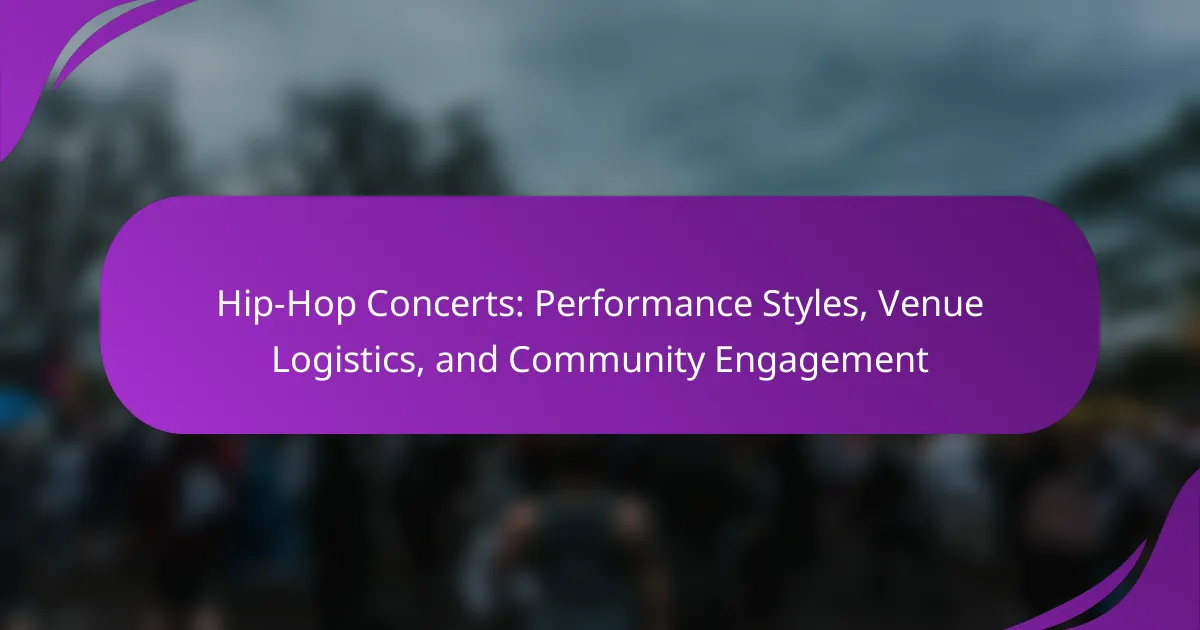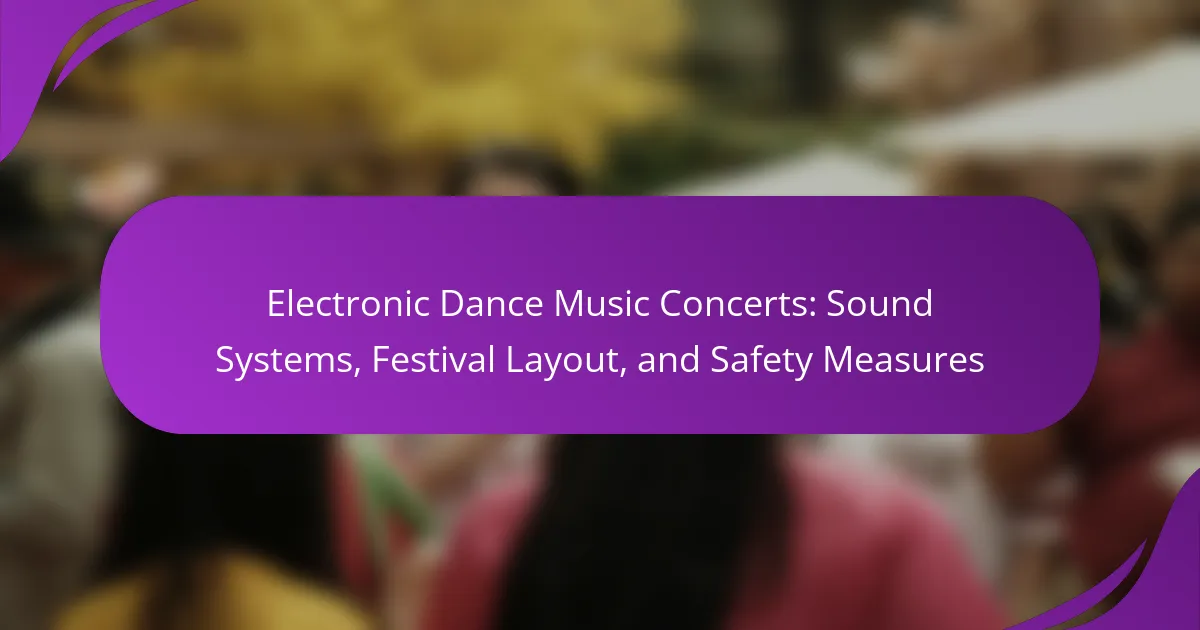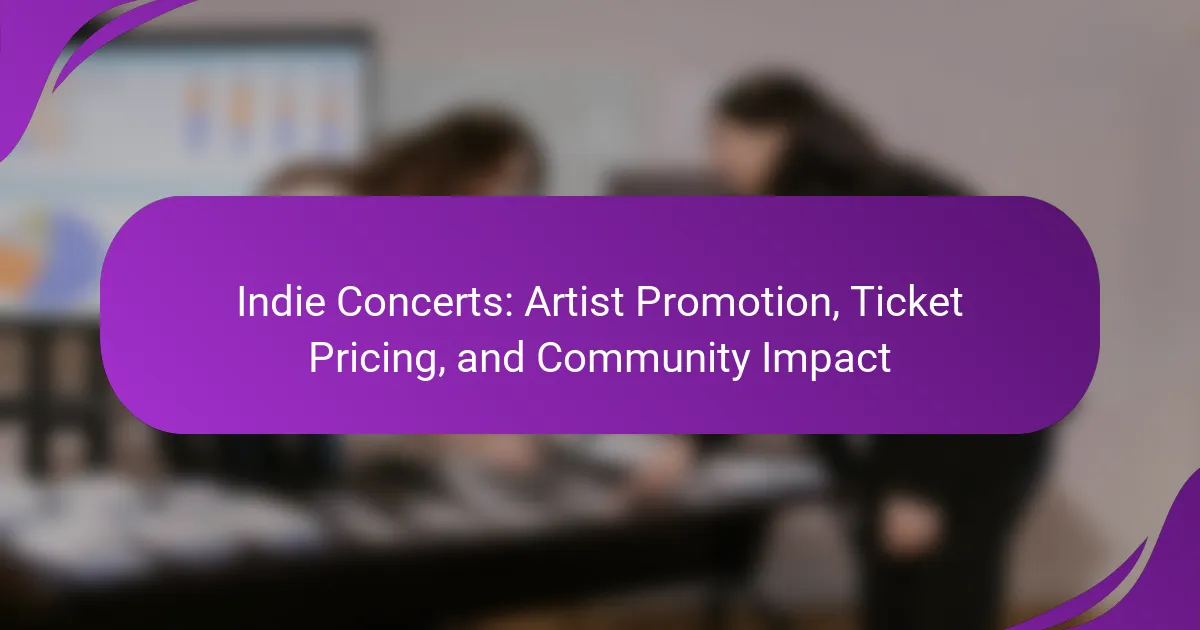Virtual concerts are live musical performances streamed online, enabling artists to connect with audiences remotely through digital platforms. These events gained traction during the COVID-19 pandemic and often incorporate interactive features like live chats and virtual meet-and-greets, significantly impacting the music industry with over $100 million in ticket sales reported in 2020. The article outlines the technology requirements for hosting virtual concerts, including internet speed, audio and video equipment, and streaming software. It also explores audience interaction through various digital tools, emphasizing the importance of engagement, as well as accessibility features designed to ensure inclusivity for all attendees.
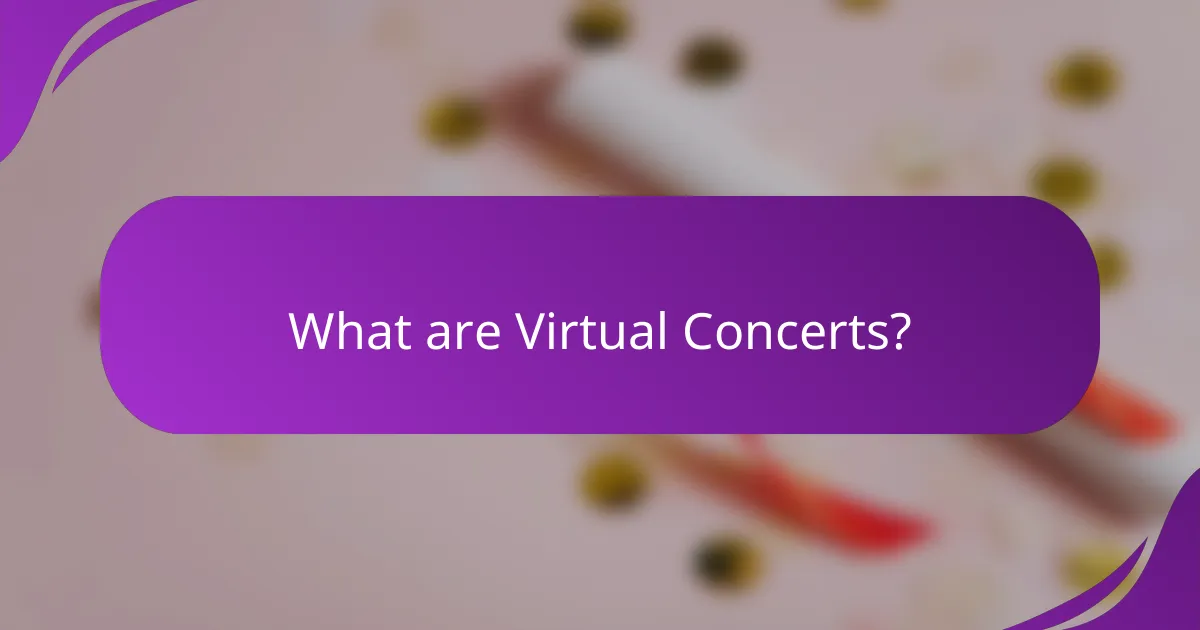
What are Virtual Concerts?
Virtual concerts are live musical performances that are streamed online. They allow artists to reach audiences remotely through digital platforms. Virtual concerts can be accessed from various devices, including computers, tablets, and smartphones. They gained popularity during the COVID-19 pandemic when traditional in-person events were restricted. These concerts often include interactive features such as live chats and virtual meet-and-greets. According to a report by Pollstar, virtual concerts generated over $100 million in ticket sales in 2020. This demonstrates their significant impact on the music industry.
How do Virtual Concerts differ from traditional concerts?
Virtual concerts differ from traditional concerts primarily in their format and delivery method. Traditional concerts occur in physical venues with live audiences. Virtual concerts take place online, allowing viewers to participate from anywhere with internet access.
In traditional concerts, attendees experience live performances in real-time, often interacting directly with the artists. Virtual concerts utilize streaming technology to broadcast performances, which may include pre-recorded elements or interactive features.
Audience interaction in traditional concerts is direct and immediate, while virtual concerts often rely on chat features or social media for engagement. Accessibility is another key difference; virtual concerts can reach a global audience, removing geographical barriers associated with traditional venues.
These differences highlight how technology reshapes the concert experience, making it more inclusive and adaptable to various audience needs.
What technology enables Virtual Concerts?
Virtual concerts are enabled by a combination of streaming technology, virtual reality (VR), and augmented reality (AR). Streaming technology allows live performances to be broadcast over the internet. This technology includes platforms like YouTube Live and Twitch. Virtual reality creates immersive environments for users to experience concerts as if they were physically present. Augmented reality enhances live performances by overlaying digital elements onto the real world. These technologies facilitate audience interaction through features like chat and live polling. Additionally, 3D audio technology enhances sound quality, making experiences more realistic. According to a report by PwC, the virtual concert market is expected to grow significantly, indicating the increasing reliance on these technologies.
What are the key features of Virtual Concerts?
Virtual concerts feature live streaming technology, allowing real-time performances from artists. They utilize high-quality audio and video to enhance the viewer experience. Interactive elements, such as chat functions, enable audience participation. Many platforms offer virtual reality experiences for immersive viewing. Accessibility features include closed captioning and multi-language support. Ticketing systems vary, with options for free and paid access. Social media integration allows for sharing and promotion. Data analytics provide insights into viewer engagement and preferences.
What are the benefits of attending Virtual Concerts?
Attending virtual concerts offers several benefits. First, they provide accessibility to a wider audience. People can enjoy performances from the comfort of their homes. This eliminates travel costs and time. Additionally, virtual concerts often feature diverse artists from various locations. This allows fans to discover new music they may not encounter otherwise.
Moreover, virtual concerts can include interactive features. Viewers can engage with artists through live chats and Q&A sessions. This enhances the overall experience and fosters a sense of community.
Furthermore, virtual concerts often have lower ticket prices compared to in-person events. This makes live music more affordable for many fans.
Finally, virtual concerts can be recorded and made available for later viewing. This allows fans to revisit performances at their convenience. Overall, virtual concerts combine convenience, affordability, and accessibility, making them a valuable experience for music lovers.
How do Virtual Concerts enhance accessibility for audiences?
Virtual concerts enhance accessibility for audiences by eliminating geographical barriers. They allow individuals from different locations to attend events without travel costs or time. People with disabilities can participate without physical constraints. Virtual platforms often include features like closed captioning and sign language interpretation. These features cater to diverse audience needs. According to a report by Eventbrite, 75% of attendees prefer virtual events for their convenience. This data highlights the growing demand for accessible entertainment options. Virtual concerts also offer on-demand viewing, further increasing accessibility for those with scheduling conflicts.
What unique experiences do Virtual Concerts offer compared to live events?
Virtual concerts offer immersive experiences that differ from live events. They provide access to global audiences regardless of geographical limitations. Attendees can enjoy high-definition visuals and enhanced audio quality from the comfort of their homes. Virtual concerts often incorporate interactive features, such as real-time chats and polls, allowing for audience participation. Customizable viewing angles and virtual reality options create a personalized experience. Additionally, virtual concerts can include behind-the-scenes content not typically available at live events. They also eliminate travel and accommodation costs, making them more accessible to diverse audiences. These unique attributes highlight how virtual concerts redefine the concert experience.
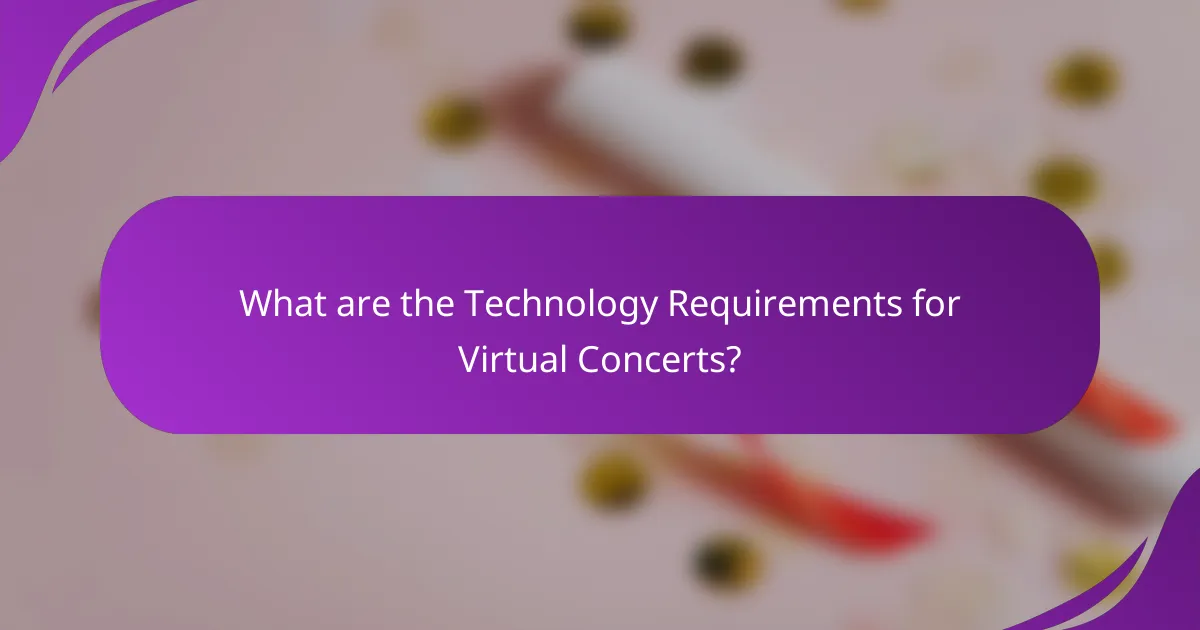
What are the Technology Requirements for Virtual Concerts?
Virtual concerts require a stable internet connection, high-quality audio and video equipment, and a suitable streaming platform. A minimum internet speed of 5 Mbps is recommended for smooth streaming. Professional-grade microphones enhance audio clarity. Cameras with at least 1080p resolution improve video quality. A reliable streaming software is necessary to manage the broadcast. Additionally, interactive features like chat and polls enhance audience engagement. These requirements ensure a successful virtual concert experience.
What hardware is needed for hosting Virtual Concerts?
To host virtual concerts, essential hardware includes a powerful computer, high-quality audio interface, and professional microphones. A powerful computer ensures smooth performance during streaming. High-quality audio interfaces improve sound quality significantly. Professional microphones capture clear audio from performers. Additionally, cameras are crucial for video quality. Webcams or professional cameras can be used for streaming. A stable internet connection is also vital to prevent interruptions. Finally, lighting equipment enhances the visual experience for viewers. These components combined create an effective virtual concert setup.
Which software platforms are commonly used for Virtual Concerts?
Common software platforms used for virtual concerts include Zoom, YouTube Live, and Twitch. Zoom allows for interactive engagement with audiences through video conferencing. YouTube Live provides a vast reach and is user-friendly for streaming. Twitch is popular for its gaming community but also hosts music events. Other platforms like Facebook Live and Stageit are also utilized for virtual performances. These platforms support various features like chat interaction and donation options, enhancing audience participation.
How do streaming quality and bandwidth impact the experience?
Streaming quality and bandwidth significantly impact the user experience during virtual concerts. High streaming quality ensures clear audio and video, enhancing engagement. Low bandwidth can lead to buffering and pixelation, disrupting the experience. According to a study by Akamai, 47% of users expect a web page to load in two seconds or less. If streaming quality is poor, users may abandon the concert. The recommended bandwidth for HD streaming is at least 5 Mbps. Insufficient bandwidth results in lower resolution and audio quality, affecting audience enjoyment.
What are the best practices for setting up technology for Virtual Concerts?
The best practices for setting up technology for virtual concerts include ensuring high-quality audio and video equipment. Invest in professional microphones and cameras to enhance sound and visual clarity. Use a reliable streaming platform that supports high-definition broadcasts. Test your internet connection to ensure stability and sufficient bandwidth, aiming for at least 5 Mbps upload speed. Implement a multi-camera setup for dynamic viewing angles. Incorporate interactive features like live chat or polls to engage the audience. Ensure compatibility with various devices to maximize accessibility for all users. Lastly, rehearse the entire setup before the event to troubleshoot any potential issues.
How can artists optimize their equipment for better sound quality?
Artists can optimize their equipment for better sound quality by using high-quality microphones and audio interfaces. High-quality microphones capture sound more accurately, reducing distortion. Audio interfaces convert analog signals to digital with minimal noise. Artists should also use proper acoustic treatment in their performance space. Acoustic panels and bass traps can minimize unwanted echoes and reverb. Regularly updating software and firmware for audio equipment ensures optimal performance. Additionally, artists should conduct sound checks before performances to identify and address any issues. Using balanced cables helps reduce interference and noise in the signal chain. These practices collectively enhance overall sound quality during virtual concerts.
What troubleshooting tips can help during a Virtual Concert?
Check your internet connection. A stable connection is crucial for streaming. Use a wired connection if possible. Restart your router if you experience interruptions. Close unnecessary applications to free up bandwidth. Ensure your device’s software is up to date. Use headphones to improve audio quality. Adjust audio settings within the streaming platform. Test your microphone and camera before the concert starts.
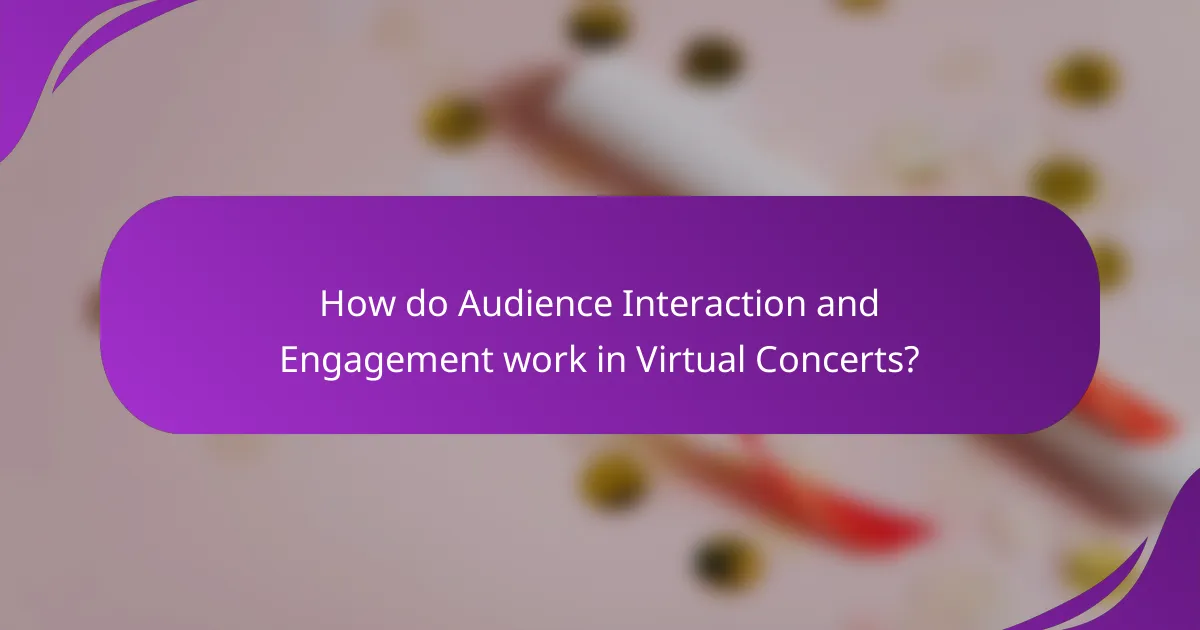
How do Audience Interaction and Engagement work in Virtual Concerts?
Audience interaction and engagement in virtual concerts occur through various digital platforms and tools. These platforms allow real-time communication between artists and audiences. Features like live chat enable viewers to send messages and reactions during performances. Polls and Q&A sessions foster direct participation from the audience. Social media integration allows fans to share their experiences and connect with others. Gamification elements, such as rewards and challenges, enhance engagement. According to a 2021 report by Eventbrite, 75% of virtual concert attendees valued interactive features. This statistic highlights the importance of engagement in enhancing the overall experience.
What tools are used for audience interaction during Virtual Concerts?
Tools used for audience interaction during virtual concerts include chat features, polls, and social media integration. Chat features allow real-time communication between attendees and performers. Polls engage the audience by soliciting their opinions or preferences during the concert. Social media integration enables sharing experiences and reactions on platforms like Twitter and Instagram. Live Q&A sessions encourage direct interaction with artists. Virtual reality platforms enhance immersion and engagement. These tools collectively enhance the audience’s experience and participation in virtual concerts.
How can chat features enhance audience participation?
Chat features enhance audience participation by facilitating real-time interaction. They allow attendees to communicate instantly with each other and the performers. This interaction creates a sense of community among participants. Studies show that events with chat features see a 30% increase in audience engagement. Participants can ask questions, share experiences, and express reactions during the event. This immediate feedback loop keeps the audience engaged and invested. Additionally, chat features can be moderated to ensure a positive environment. Overall, these tools significantly boost the interactive experience of virtual concerts.
What role do social media platforms play in audience engagement?
Social media platforms play a crucial role in audience engagement during virtual concerts. They provide real-time interaction opportunities between artists and fans. Platforms like Facebook, Instagram, and Twitter facilitate live chats and comments. This allows audiences to express their thoughts and feelings instantly. According to a study by Eventbrite, 83% of attendees engage with artists on social media during events. Additionally, social media helps in promoting events, increasing visibility and attendance. Engaging content shared on these platforms can lead to higher audience participation. This interactive environment enhances the overall concert experience for viewers.
How can artists create a sense of community in Virtual Concerts?
Artists can create a sense of community in virtual concerts by fostering real-time interaction. They can utilize live chat features to engage with the audience during performances. This allows fans to share their thoughts and reactions instantly. Artists can also host Q&A sessions, encouraging fans to ask questions and feel involved. Incorporating social media hashtags can help unify conversations around the event. Additionally, creating virtual meet-and-greets can deepen connections with fans. Collaborative performances with other artists can also enhance community feelings. Research shows that interactive elements in virtual events increase audience engagement and satisfaction. This proves that these strategies effectively build community in virtual concert settings.
What strategies can be used to encourage audience interaction?
Engaging audience interaction in virtual concerts can be achieved through several strategies. Incorporating live polls encourages real-time feedback from attendees. Utilizing chat features allows participants to share their thoughts and reactions during the event. Hosting Q&A sessions gives the audience a chance to interact directly with performers. Gamification elements, such as contests or challenges, can increase engagement levels. Offering exclusive content or experiences for active participants fosters a sense of community. Additionally, using social media integration allows attendees to share their experiences, further promoting interaction. Research indicates that events with interactive elements see up to 30% higher audience engagement rates.
How do polls and Q&A sessions contribute to engagement?
Polls and Q&A sessions enhance audience engagement by actively involving participants in the event. They allow attendees to express their opinions and ask questions in real-time. This interaction fosters a sense of community among participants. According to a study by Eventbrite, 70% of attendees feel more engaged when they can interact through polls and Q&A. Additionally, these features provide immediate feedback to organizers, helping them tailor the experience to audience preferences. Engaging activities like these can lead to higher satisfaction rates, as 80% of participants in interactive sessions report a more enjoyable experience.
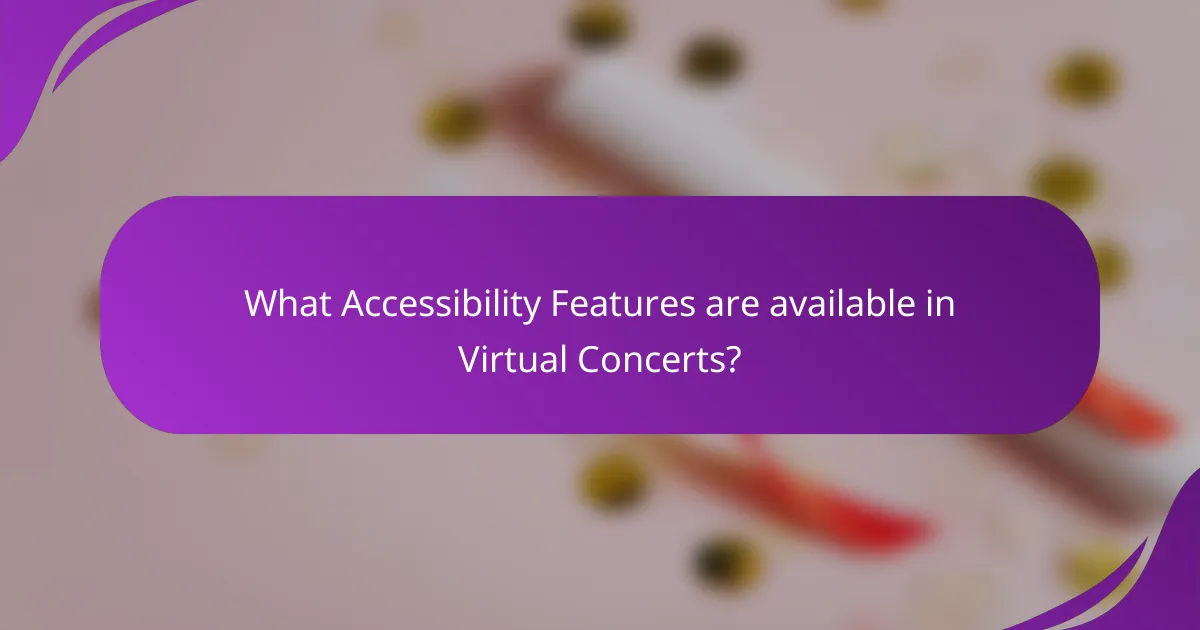
What Accessibility Features are available in Virtual Concerts?
Virtual concerts offer several accessibility features to enhance user experience. These features include closed captioning for the hearing impaired. Sign language interpretation is often provided during performances. Audio descriptions cater to visually impaired attendees. Adjustable video settings allow users to customize their viewing experience. Interactive chat options enable real-time communication and engagement. Additionally, some platforms offer multi-language support for diverse audiences. These accessibility features ensure that virtual concerts are inclusive for all attendees.
How do Virtual Concerts cater to individuals with disabilities?
Virtual concerts cater to individuals with disabilities by incorporating various accessibility features. These features include closed captioning for hearing-impaired attendees. Sign language interpretation is often provided during performances. Virtual environments allow for customizable viewing experiences. Individuals can adjust settings for better visibility and comfort. Many platforms offer audio descriptions for visually impaired users. The online format eliminates physical barriers to attendance. Research indicates that virtual events can increase participation among disabled individuals. A study by the National Endowment for the Arts found that accessibility features significantly enhance engagement.
What are the common accessibility features in streaming platforms?
Common accessibility features in streaming platforms include closed captioning, audio descriptions, and screen reader compatibility. Closed captioning provides text representation of spoken dialogue and sounds. This feature aids individuals who are deaf or hard of hearing. Audio descriptions deliver verbal narration of visual elements in the content. This assists viewers with visual impairments. Screen reader compatibility allows users to access content through text-to-speech technology. This feature is essential for individuals with blindness or low vision. Additional features may include adjustable playback speeds and keyboard navigation options. These enhancements improve user experience for people with various disabilities.
How can captions and sign language interpreters enhance accessibility?
Captions and sign language interpreters enhance accessibility by providing visual communication for individuals with hearing impairments. Captions display spoken dialogue and relevant sound effects on-screen. This allows deaf or hard-of-hearing individuals to understand the content. Sign language interpreters translate spoken words into sign language in real-time. This offers an alternative for those who prefer sign language as their primary mode of communication. Research indicates that over 5% of the world’s population experiences disabling hearing loss. Accessibility features like captions and interpreters ensure that virtual concerts are inclusive. They promote equal participation in cultural and entertainment events.
What are the challenges in ensuring accessibility for Virtual Concerts?
Ensuring accessibility for virtual concerts faces several challenges. One major challenge is the lack of universal design standards. Many platforms do not cater to individuals with disabilities. This results in limited access for those who are deaf or hard of hearing. Another challenge is the digital divide. Not everyone has reliable internet access or the necessary technology. This limits participation in virtual concerts. Additionally, content may not be optimized for screen readers. This affects visually impaired users. Finally, there is often insufficient awareness of accessibility features. Many event organizers overlook the importance of inclusive practices. These challenges hinder the goal of making virtual concerts accessible to all.
How can artists and organizers improve accessibility in future events?
Artists and organizers can improve accessibility in future events by implementing inclusive design practices. They should ensure venues are wheelchair accessible and provide clear signage. Offering live captioning and sign language interpretation enhances communication for attendees with hearing impairments. Providing sensory-friendly spaces can support individuals with sensory sensitivities. Additionally, utilizing online platforms can allow remote participation for those unable to attend in person. Research shows that 1 in 4 adults in the U.S. have a disability, highlighting the need for accessible options. By prioritizing these measures, events can become more inclusive and welcoming for all participants.
What tips can enhance the Virtual Concert experience for all attendees?
To enhance the virtual concert experience for all attendees, focus on interactive features and technical quality. Ensure high-quality audio and video to create an immersive atmosphere. Use chat functions to allow real-time audience interaction. Incorporate polls and Q&A sessions to engage viewers actively. Provide multiple viewing options, such as different camera angles. Consider accessibility features, like closed captioning for hearing-impaired attendees. Promote a sense of community through social media integration. Offer virtual meet-and-greet opportunities with performers. These strategies can significantly improve attendee satisfaction and engagement during virtual concerts.
Virtual concerts are live musical performances streamed online, allowing artists to connect with global audiences. This article explores the technology requirements essential for hosting virtual concerts, including high-quality audio and video equipment and reliable streaming platforms. It also examines audience interaction techniques, such as live chats and polls, which enhance engagement, and highlights accessibility features like closed captioning and sign language interpretation that make these events inclusive. Overall, the content provides a comprehensive overview of how virtual concerts are reshaping the music experience through technology and community engagement.
